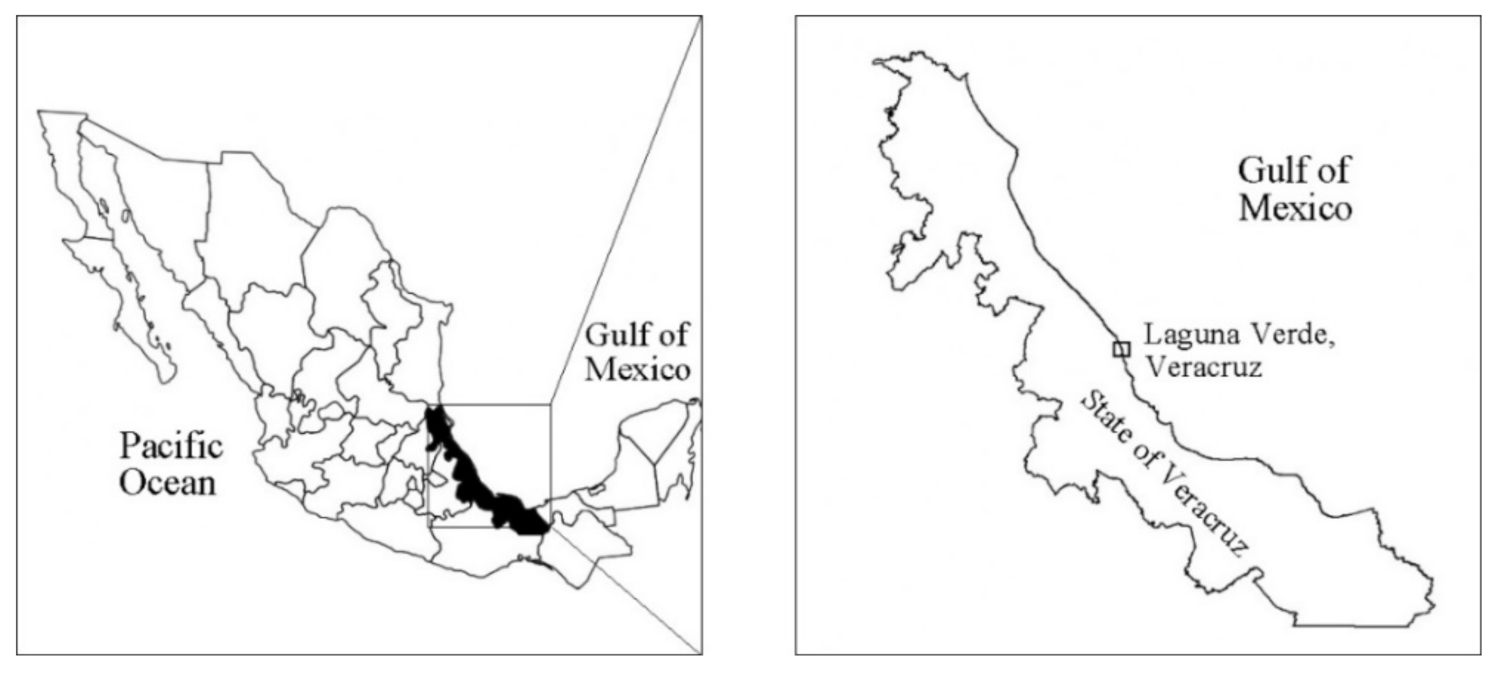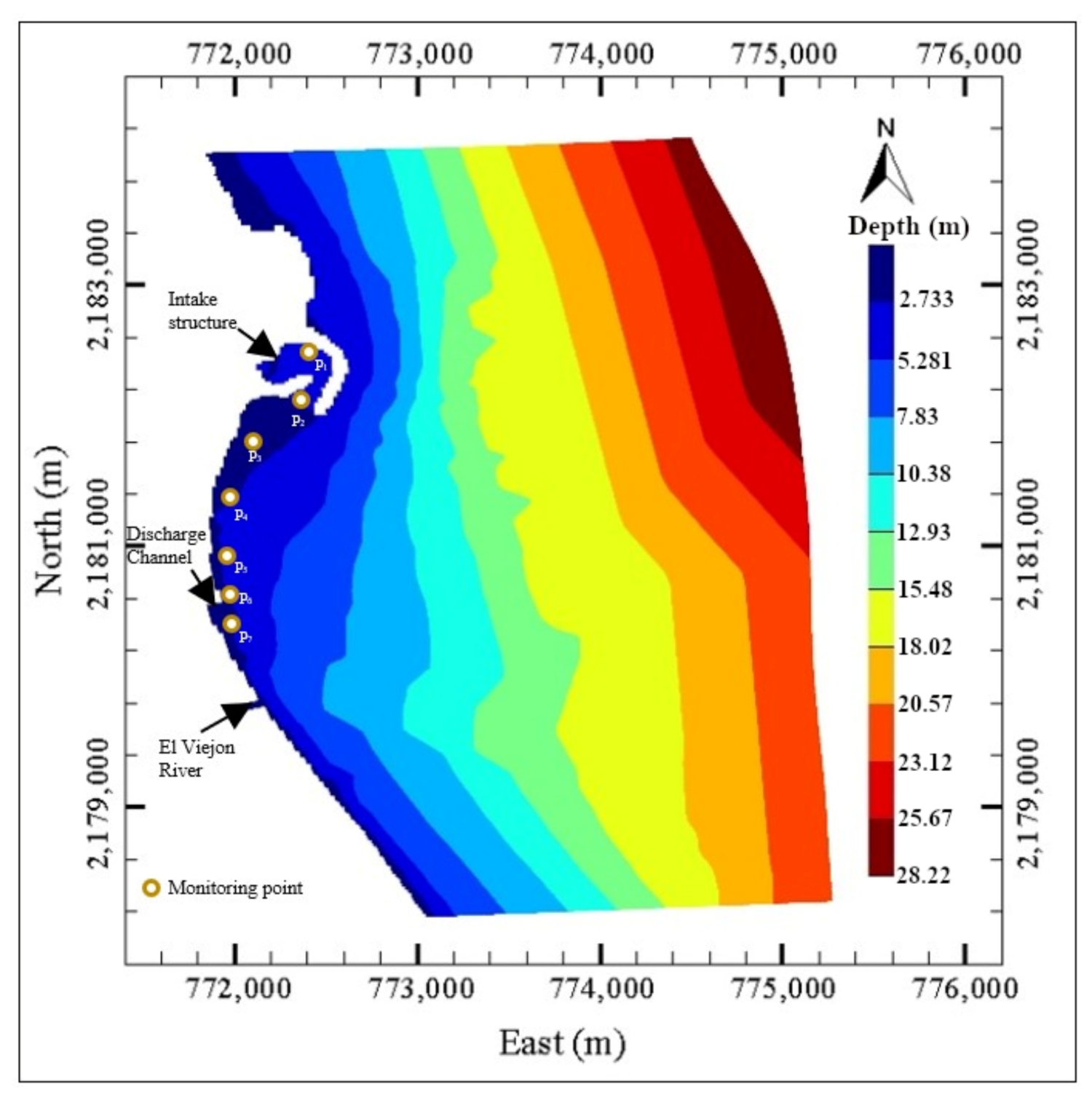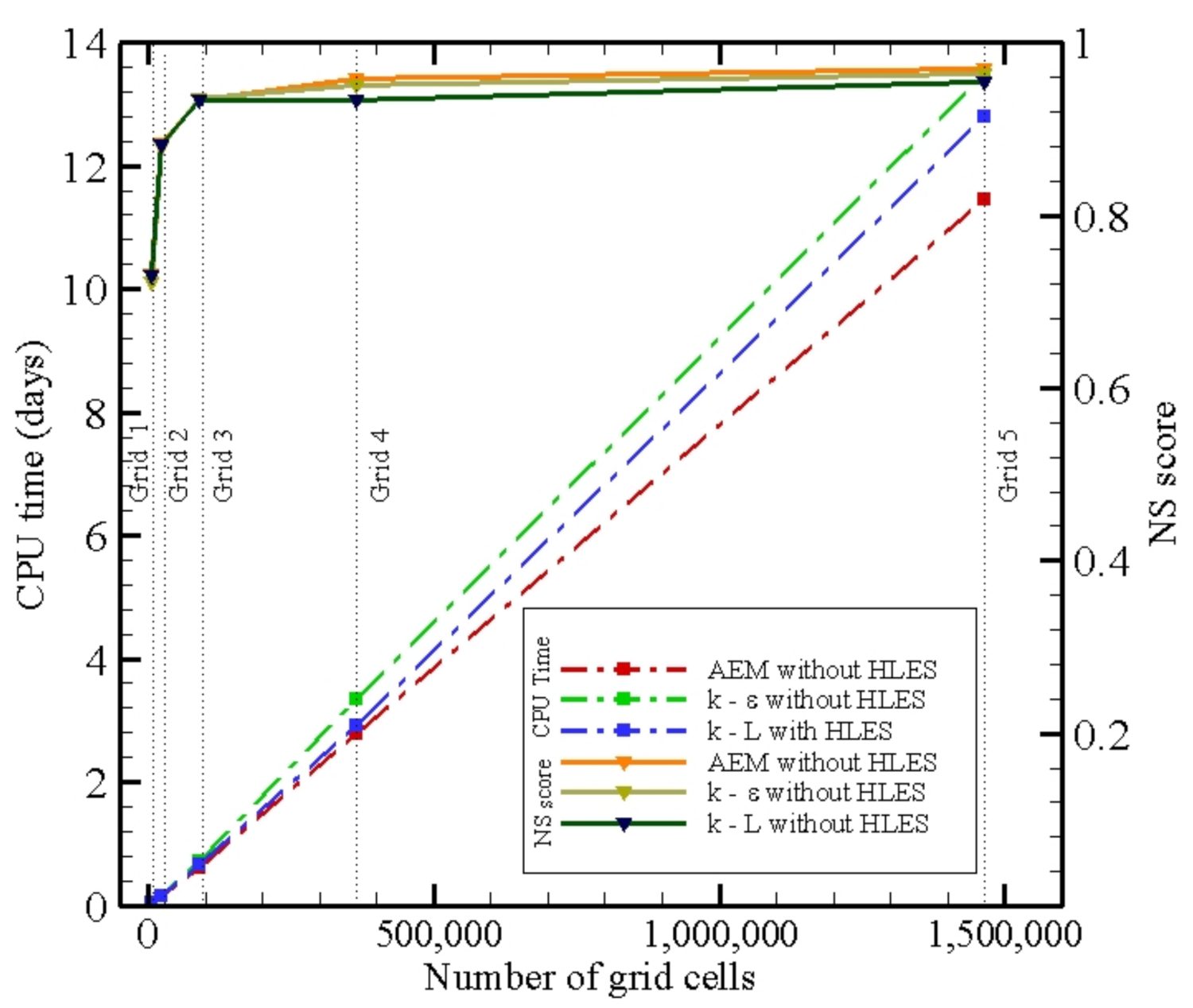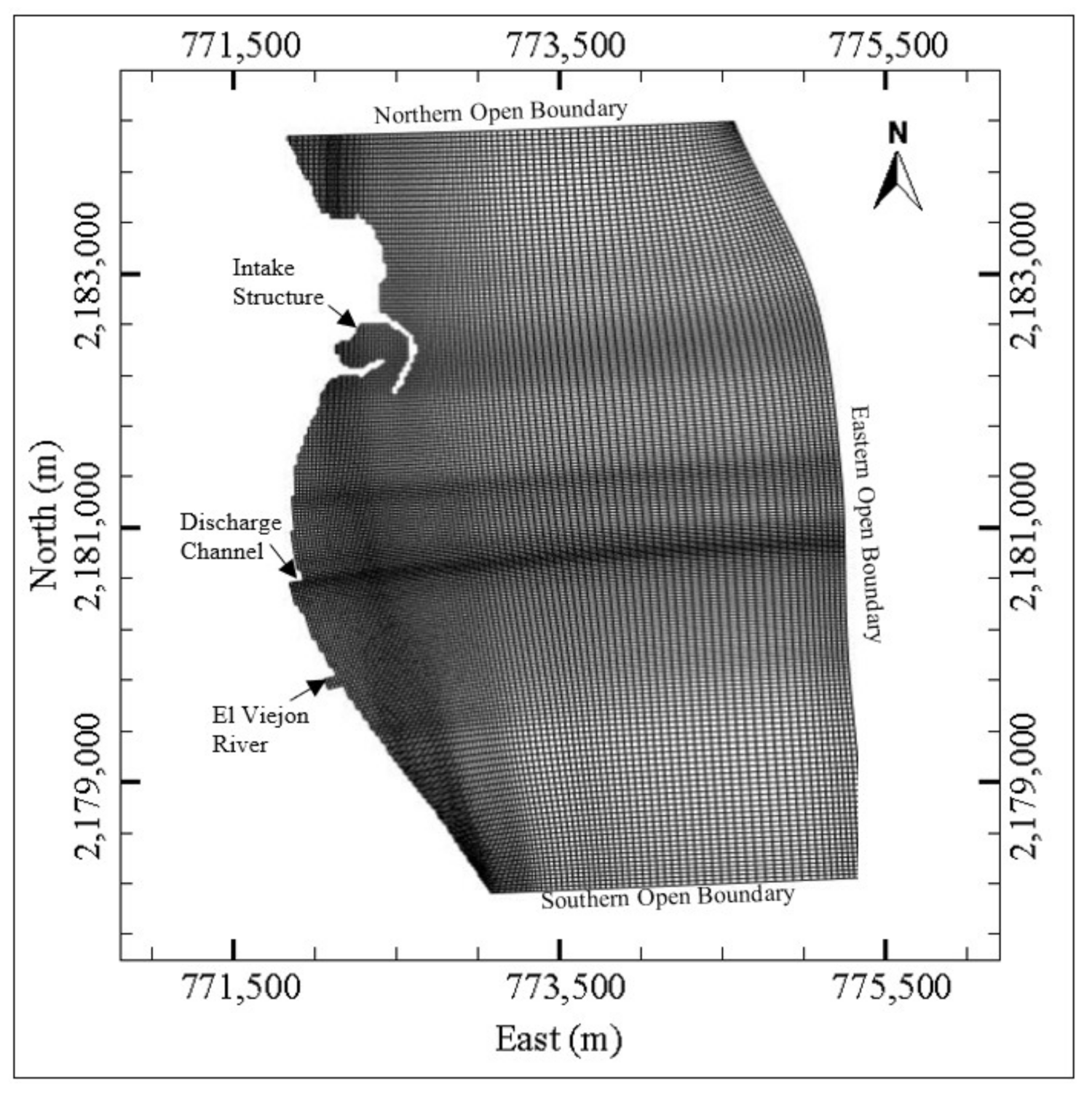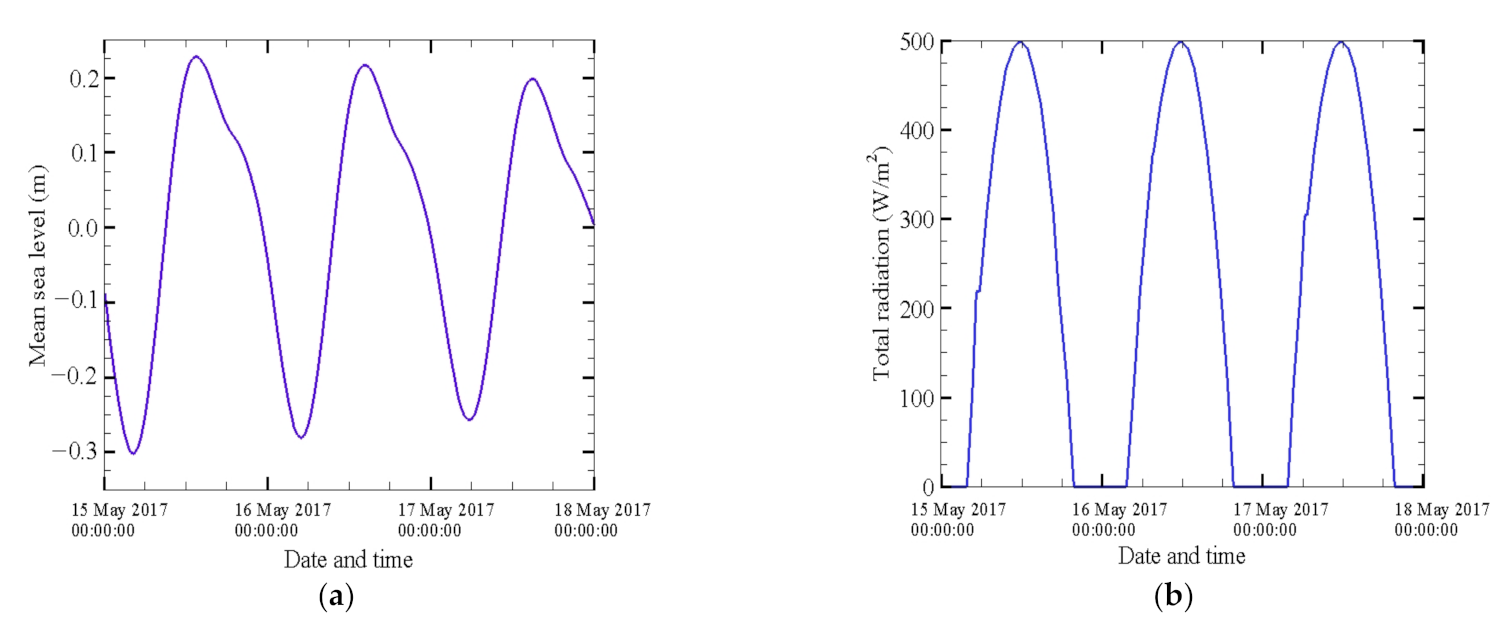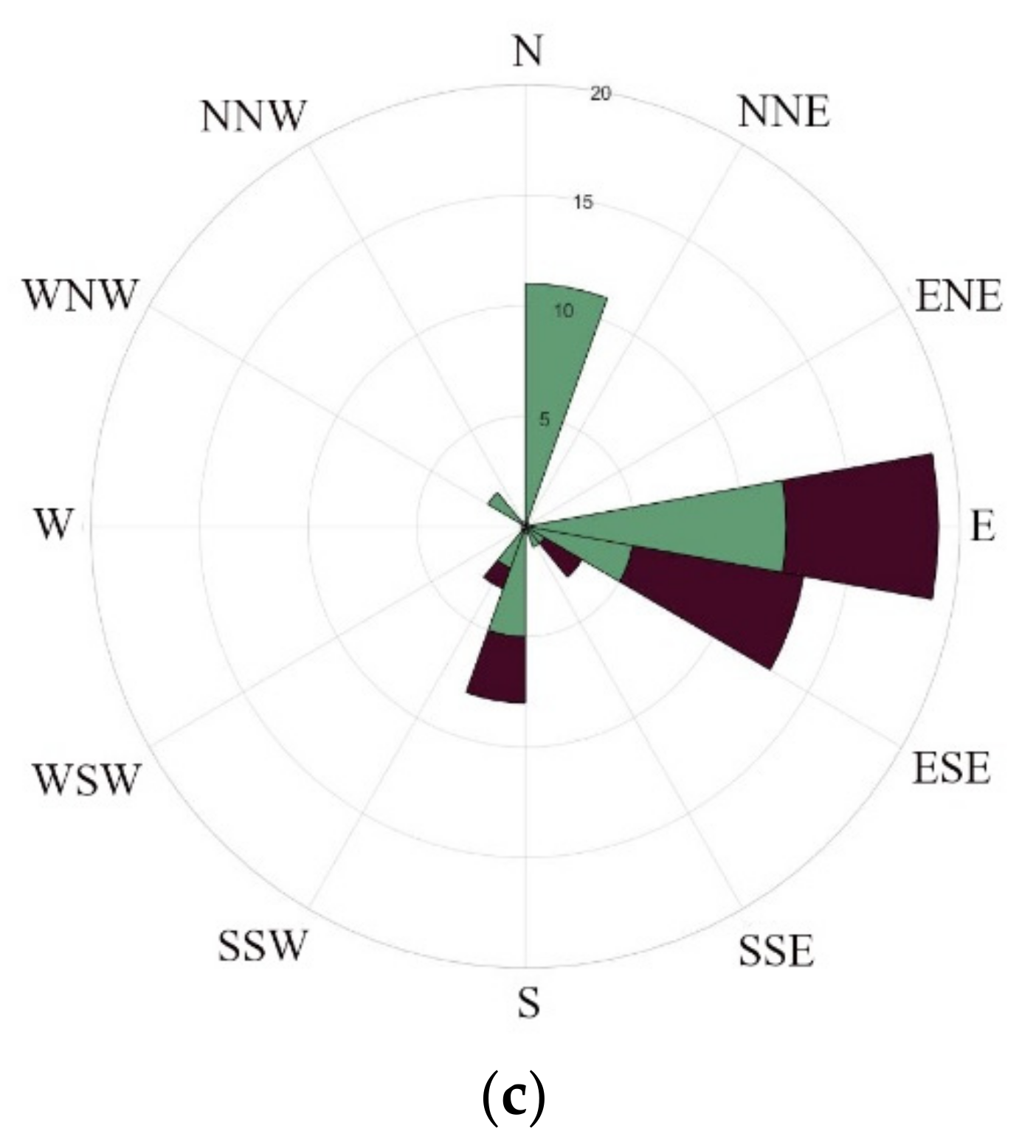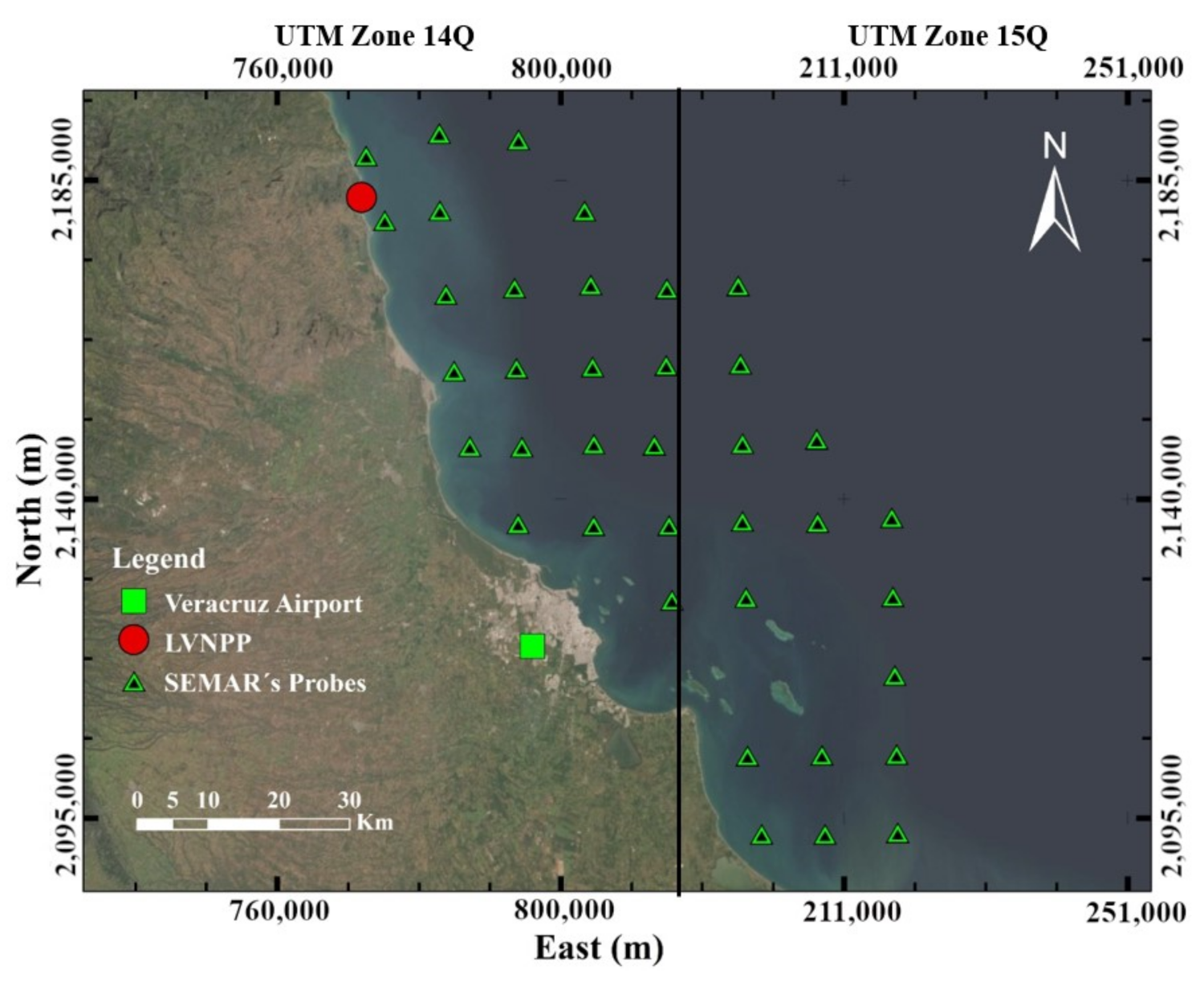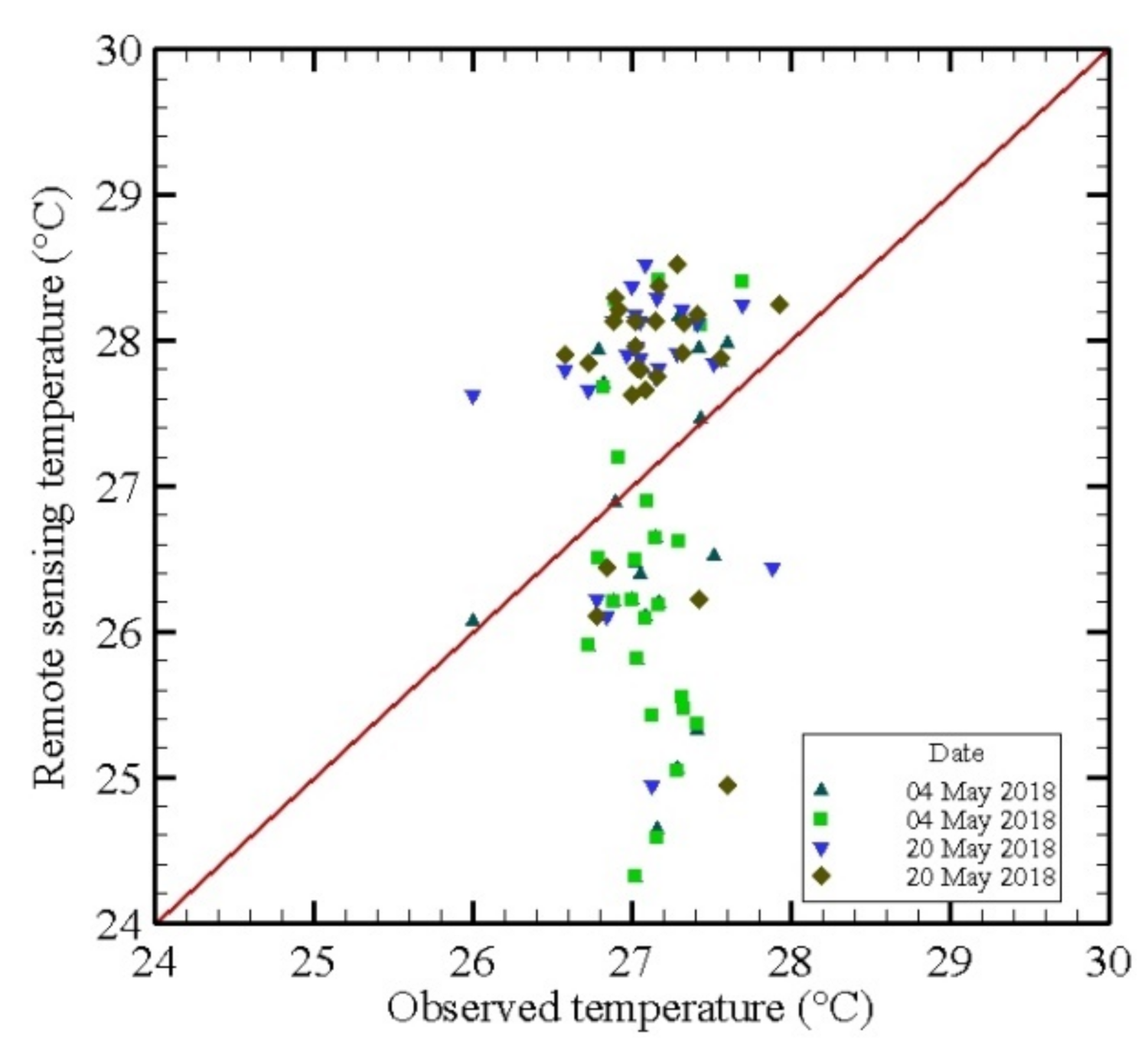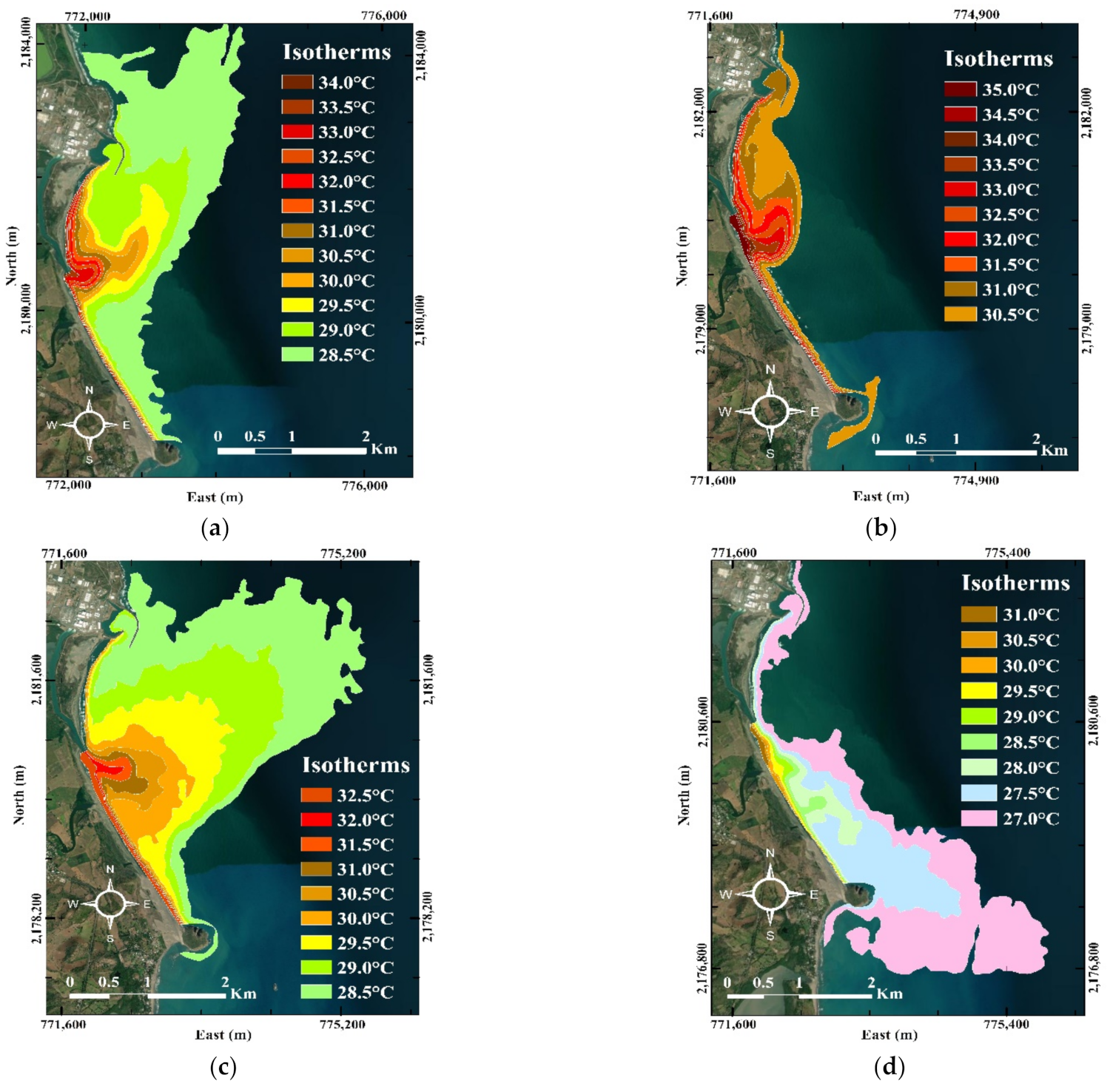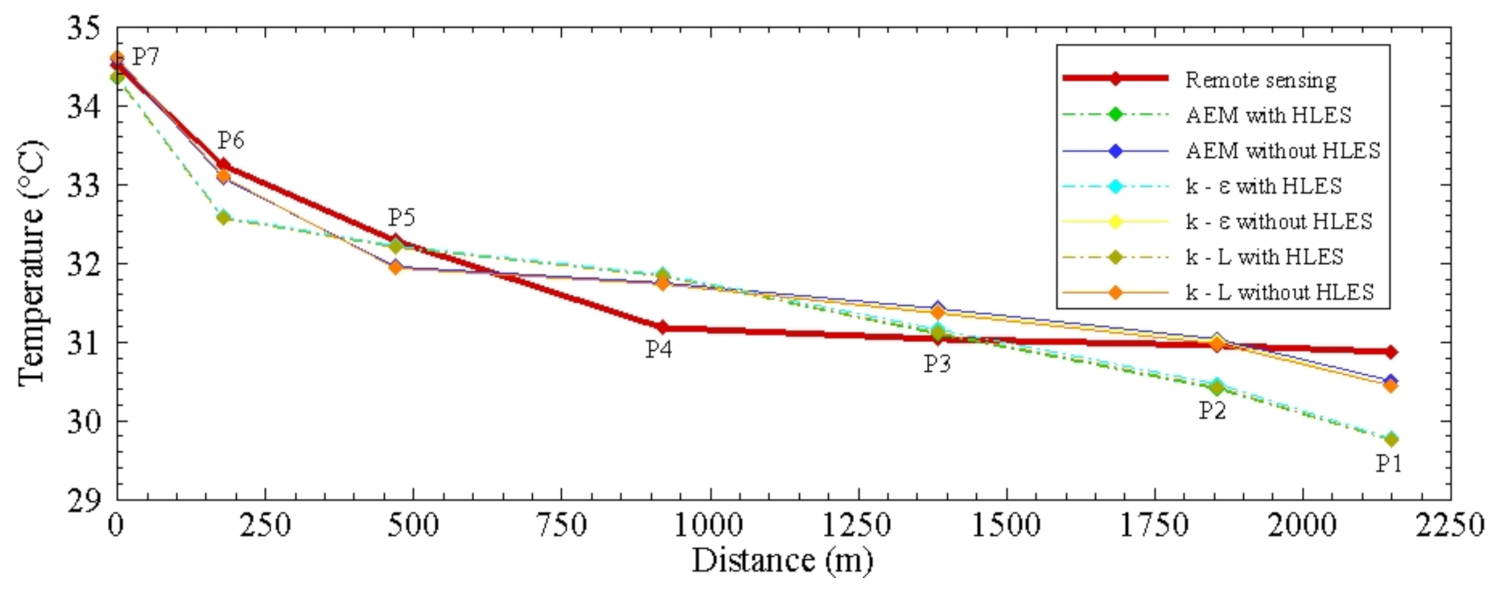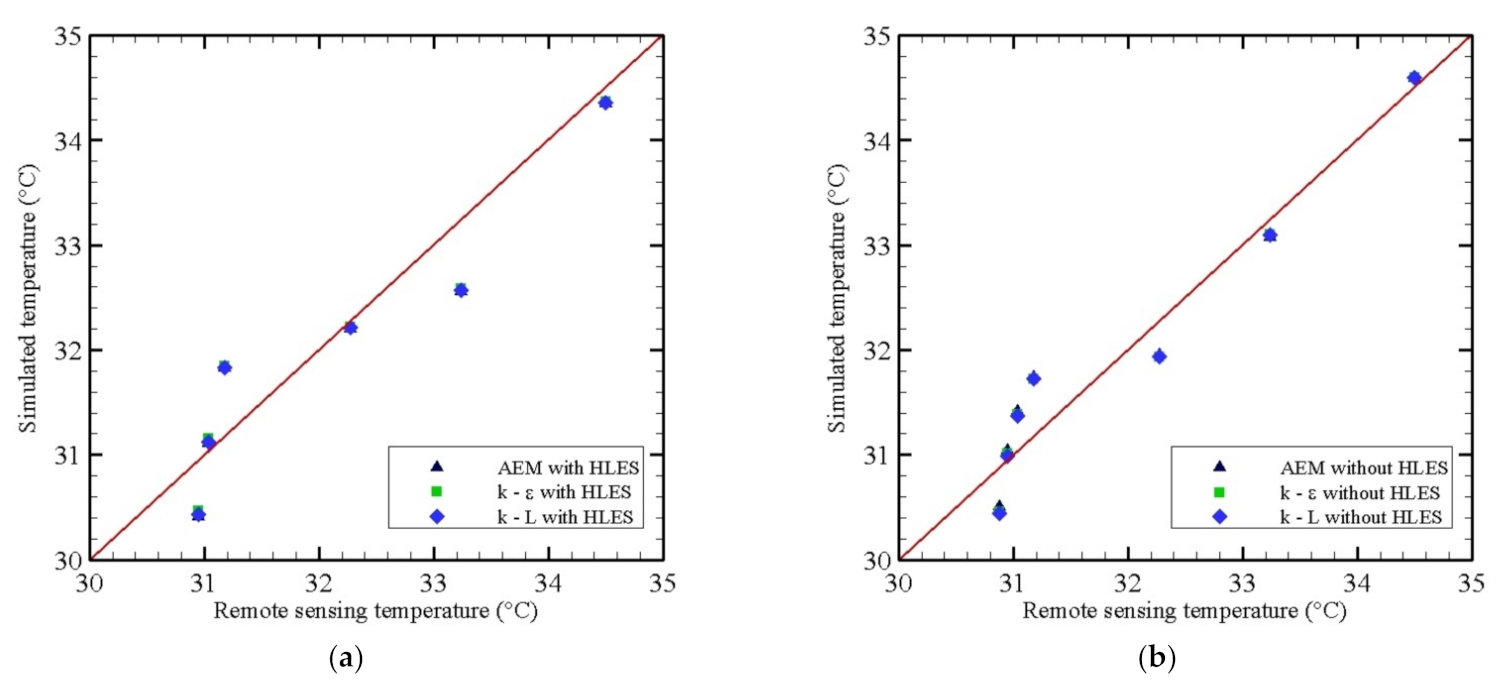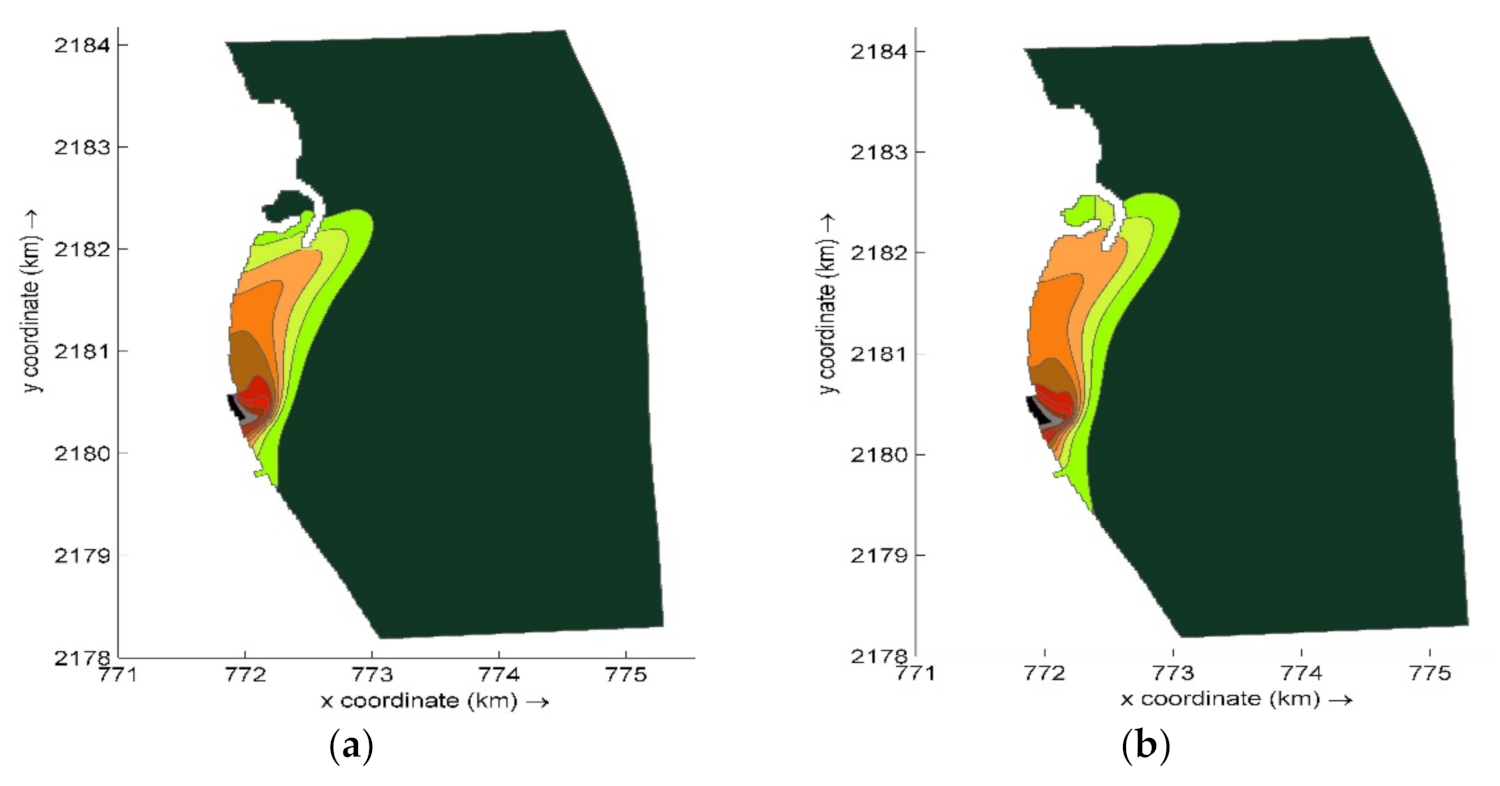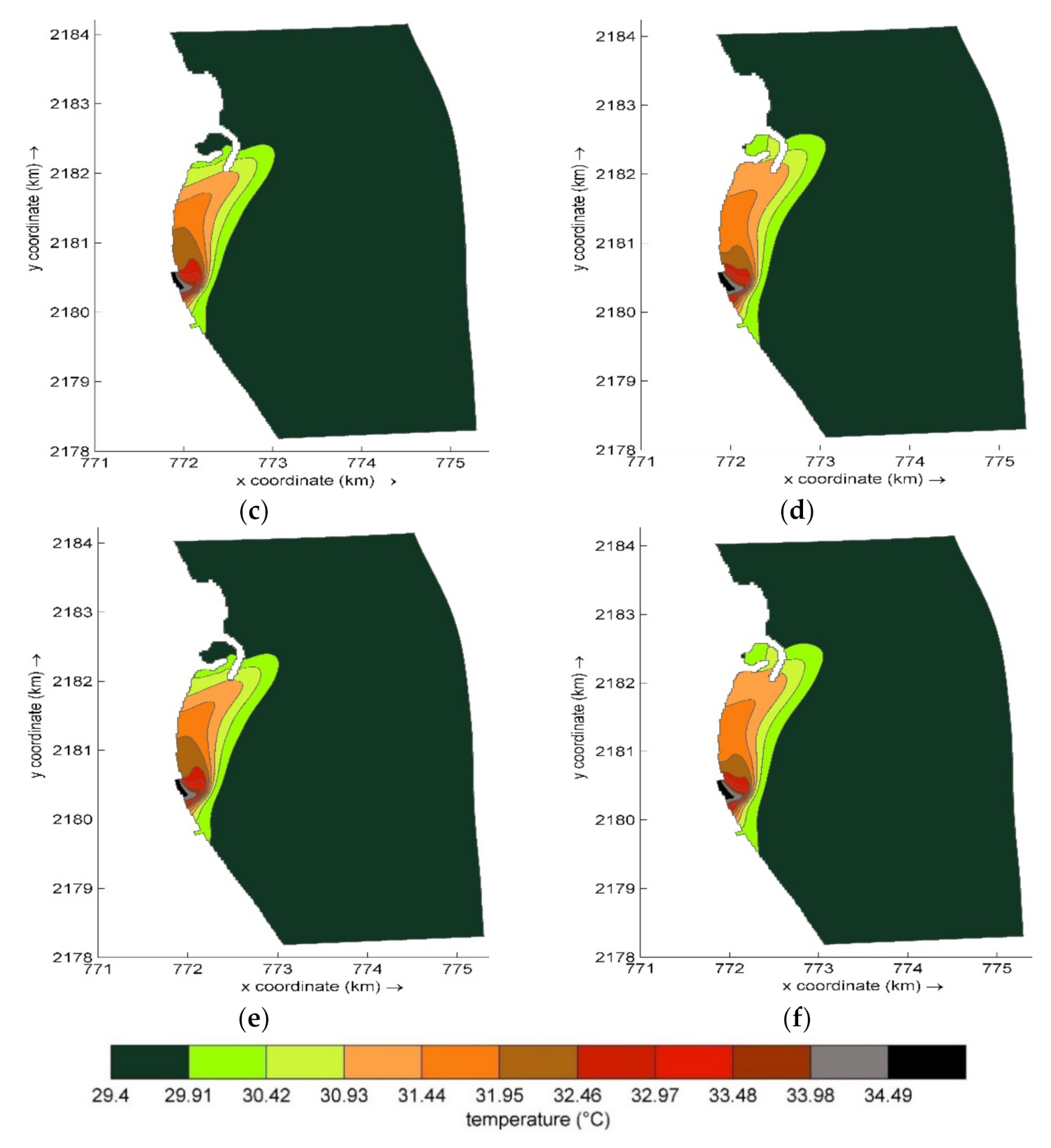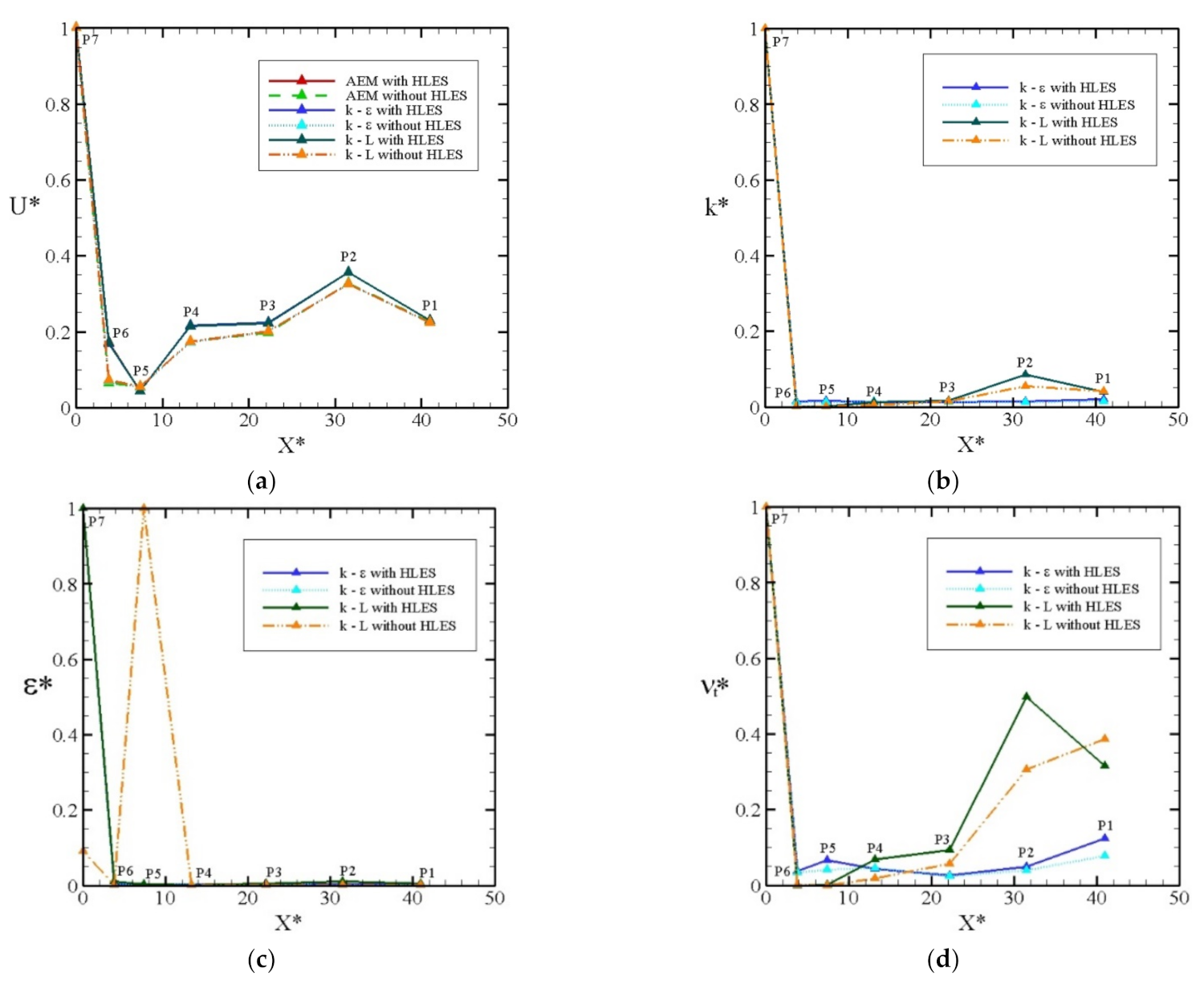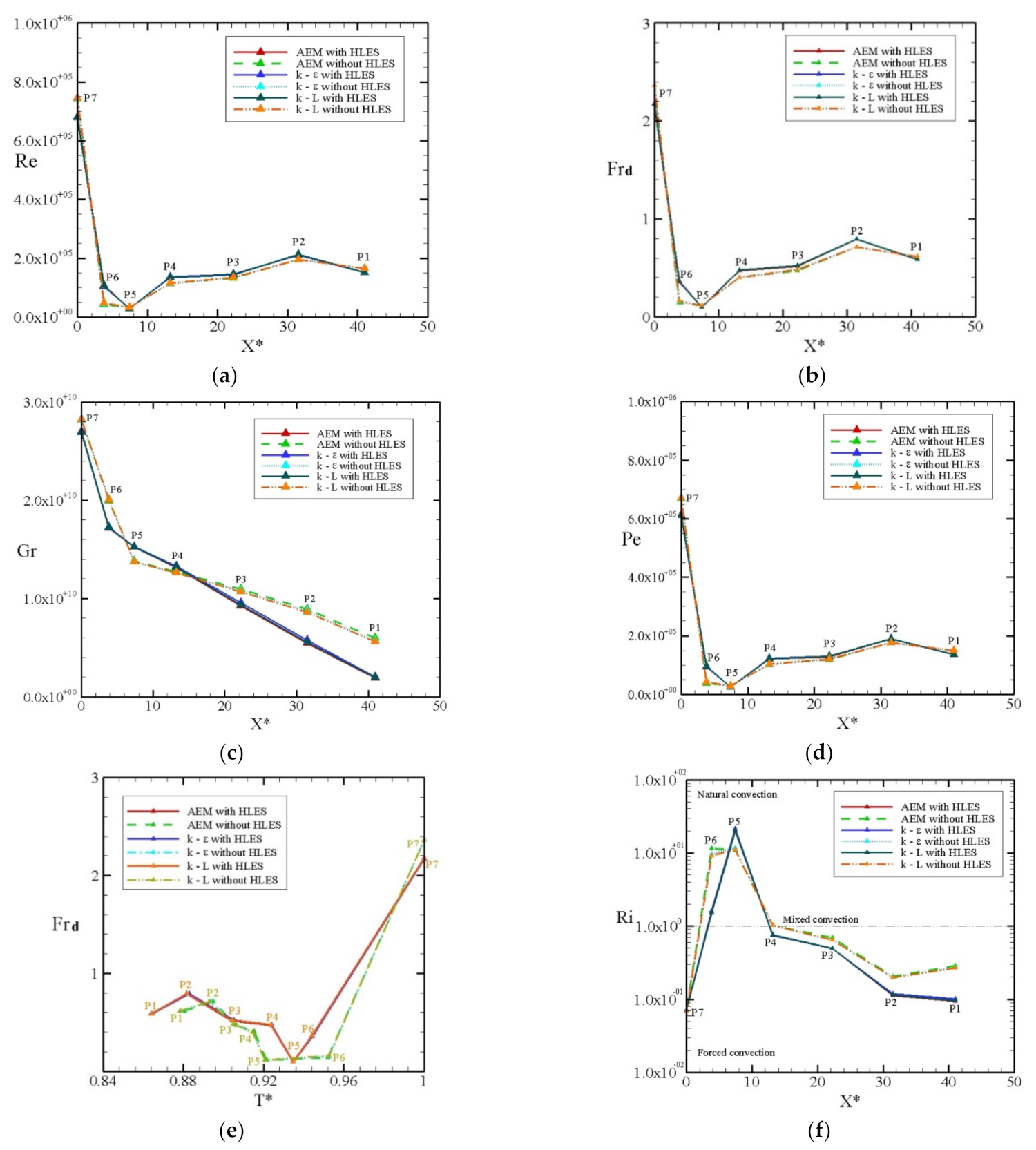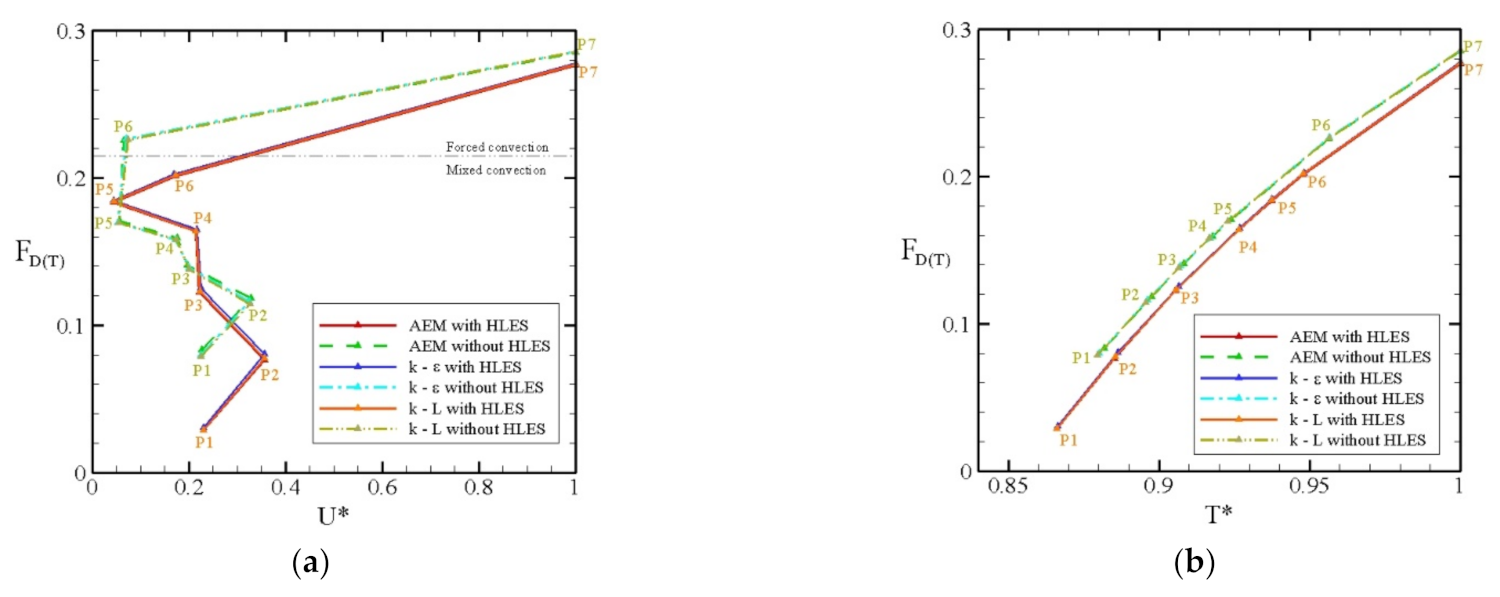3.2.1. Calibration and Validation
To expand the analysis of the thermal plume emitted by the LVNPP, numerical simulations were calibrated and validated with the aid of RS temperature fields. For this purpose, only the scenario of
Figure 8b was simulated, as it is a nonfavorable scenario for the performance of the power plant, as mentioned above. To match the scenario of RS for the spring season on 17 May 2017, the simulation period was configured from 15 May 2017 at 00:00 h to 17 May 2017 at 11:00 h, leaving two previous days for warm-up. The initial and boundary conditions are detailed in
Section 2.5. The scenario was reproduced with the AEM and the
and
turbulence closure models, activating and deactivating the HLES scheme of Delft3D-FLOW, to carry out a discussion on the performance of each model. For simulations performed with HLES, the default sub-grid scale model setup parameters were considered. The temperature at the discharge was fixed to 35 °C, whereas the temperature of the suction at the intake structure was 29.4 °C, according to the RS temperature fields. Regarding the El Viejon river, a constant temperature of 30 °C was imposed.
A trial and error process that involved increasing and decreasing the parameters
, and
was applied for satisfactory agreement with the RS data, based on the following three metrics:
where
is the root mean square error;
m is the mass balance error;
and
are the RS and simulated temperatures, respectively;
is the mean of
;
is the number of monitoring points.
Table 5 shows the final values used for the simulations. The background parameters are determinant to the variation in the results and are required to compute
, and
, as described by Equations (4), (5), (7) and (8), respectively.
Figure 9 illustrates the temperature decay curves following the monitoring points, from P7, closest to the discharge, to P1, furthest from the discharge and closest to the intake structure (
Figure 2). These results correspond to the date 17 May 2017 at 10:45 h, which is the time that matches the RS data of the same date (
Figure 8b). The solid red line shows the temperature decay curve of the RS data, while the rest of the lines depict the simulated decay curves with the different turbulence closure models.
Figure 10 shows the dispersion of RS temperatures versus simulated temperatures obtained with the different turbulence closure models at each monitor point. It is evident that more data dispersion exists when using turbulence models with HLES (
Figure 10a) compared with the ones without HLES (
Figure 10b).
Table 6 shows the corresponding errors of each simulation against the RS data. The values of the RMSE for the three turbulence closure models with HLES are around 0.59, whereas these values are lower without HLES, around 0.33. For the NS, the values with HLES for the three models are around 0.79, whereas they are around 0.93 without HLES. For the
m criterion, calculations with HLES yield values of around 0.014, whereas these are around 0.009 without HLES. In general, better agreement is observed for the simulations without HLES, and, considering the calculated bias, the simulation with the
turbulence model correlates best with the RS data.
In terms of the RMSE efficiency criterion, it may appear that some of the simulations are poorly consistent with the RS data; however, there are countless variables arising from different sources in the coastal zone, such as hydrological, meteorological, climatic, and oceanographic variables, which introduce complexity. The diversity in the temporal and spatial scales of these variables also generates a level of uncertainty. The study is therefore far from being a controlled experiment, so the RMSE correlation is acceptable in this case. On the other hand, for the NS efficiency criterion, good agreement is found with the RS data. According to [
52], an NS efficiency score greater than 0.5 indicates acceptable numerical modeling performance. Regarding the
m criterion, the values from both models (i.e., with and without HLES) are close to zero (0.014 and 0.009, respectively), indicating good approximation.
Figure 11 shows the simulated surface thermal fields of the above comparisons of the three turbulence closure models considered, with and without HLES. In general, the patterns of the simulated thermal plumes are in good agreement with those derived from the RS data (
Figure 8b). The numerical simulations closely describe the dissipation of the plume towards the intake structure, the critical scenario for the performance of the power plant cooling system. Although the overall thermal fields are similar in all cases, the results without HLES yield greater temperature values in the intake structure, as represented by the isotherms. This means that, when activating the HLES model, the heat dissipates at a higher rate, compared with the simulations without HLES. In fact, the potential core of the thermal discharge reproduced with HLES simulations covers a smaller area than the one reproduced by simulations without HLES. Finally, from the temperature fields of each turbulence closure model, AEM,
and
, no differences were observed among them.
3.2.2. Thermal Plume Dispersion Analysis
The results shown in
Section 3.2.1 are further discussed based on a behavioral analysis of several dimensionless numbers and variables.
Table 7 shows the definition of each one, where
and
are the discharge channel depth and width at the outlet, respectively (m);
is the volumetric expansion coefficient (1/°C);
is the ambient temperature set to 29.4 °C;
is the Prandtl number, equal to
;
is the standard seawater density, considered
;
is the distance from P7 to the other monitoring points (m). The parameters
(m
2/s
2),
, (m
2/s
3),
(m
2/s),
(°C), and
(m/s) are the maximum values calculated at the monitoring points.
The analyses are based on the results obtained for the monitoring points shown in
Figure 2, and their coordinates can be found in
Table 1.
Figure 12 shows the evolution of the dynamic field from P7 to P1, following the plume trajectory.
Figure 12a illustrates the evolution of
, whereas
Figure 12b–d show the dimensionless turbulent parameters
,
, and
, respectively. One of the advantages provided by the
model is that the transport of kinetic energy and its dissipation are calculated. The
model does solve the kinetic energy transport equation; however, it does not solve the turbulent dissipation transport equation. To have an approximation of the turbulent dissipation when using the
model, the semi-empirical relationship of Kolmogorov–Prandtl, Equation (9), was applied, although, as observed in
Figure 12c,d, the results do not show coherence with those obtained from the
model. The turbulent variables from the results of the AEM model were not calculated, since such a model does not even estimate the transport of kinetic energy. From the evolution of
, it was observed that, between P7 and P6, the thermal transport was dominated by advective processes arising from the momentum introduced by the discharge channel, whereas, between P5 and P1, it was dominated by diffusive processes, which govern the transport of the plume due to the force induced by surface wind shear and the inertia of the coastal marine currents. Regarding
Figure 12b–d, between P7 and P6, the decrease in the turbulence parameters is dominated by the momentum induced by the flow in the channel discharge. This is the area in which the turbulence, and consequently the dissipation, is highest. Between P6 and P1, the evolution of the turbulence parameters is dominated by diffusive processes induced by both the velocities and the temperature in the far field. There are differences between the calculations with and without HLES in the same way as there are in the mean flow.
Figure 13 shows the evolution and impact of the thermal plume, including a comparison of dimensionless numbers that relate inertial and viscous force effects, natural and forced convection, heat transfer and thermal diffusion, and finally density and buoyancy effects [
53]. Overall, the values from the models with HLES are higher than those without HLES, since an additional eddy viscosity is introduced by
. The variation of
with
is shown in
Figure 13a. In general, inertial forces predominate over viscous ones. It is worth mentioning that, from P7 to P6, higher values of
are observed; this is expected, since the highest velocities are found near the discharge. The evolution of
with
is shown in
Figure 13b. Near the discharge, inertial forces predominate over buoyancy ones up to P5. After this point, an equilibrium is observed between these two forces, with buoyancy forces slightly predominating over inertial ones, since the values of
are lower than one.
Figure 13c shows a plot of
versus
. The highest temperature gradients are found between P7 and P6, and, as expected, the highest values for
are observed at these points. From P6 to P1, the values of
are smoothly reduced as the thermal plume approaches the intake structure. Overall, buoyancy forces dominate over viscous ones. The variation of
is shown in
Figure 13d. Between P7 and P6, a predominance of convective forces over diffusive ones is observed, due to the momentum introduced by the discharge channel. Although the
curves drop down significantly at the remaining points, the process remains dominated by convective forces since the diffusive ones are not strong enough to counteract them.
Figure 13e illustrates the relationship between
and
. Between P7 and P5, inertial forces predominate over viscous and buoyancy forces. From P5 to P1, an increase in the buoyancy forces tends to counteract the inertial forces, since the curves tend towards
= 1.
Figure 13f shows an analysis of the forced and natural convection. The following criterion is used to classify the convective heat transfer mode of the flow [
54]. If
1, natural convection effects dominate; if
1, buoyancy forces are negligible, and forced convection must be considered; when
1, the flow is referred to as a mixed convection. Due to the influence of the discharge, in P7,
, but not to the degree at which forced convection dominates over natural convection. Between P6 and P4,
, but again, not to the degree at which natural convection dominates over forced convection. Because of the influence at the intake structure,
tends towards values lower than 1 at monitors P4 to P1, but still, in a regime where it is difficult to infer, forced convection dominates the process. Thus, given the behavior of
, a mixed convection regime can be implied on all the monitor points, because the values of
are not much higher or much lower than 1, a condition that evidences the predominance of forced or natural convection in the thermal process.
To determine the mode that dominates the heat transfer in the thermal plume dispersion, forced or natural convection, along the monitoring points, a dimensionless quantity was introduced as
This factor is a metric of density variations because it reflects the dimensionless density bias due to linear dilatation with respect to the reference density . In cases such as the one analyzed here, where the density variations due to temperature (dilatation) are small, this relationship helps to represent such variations in orders of magnitude close to 1. With this, whether force convection or natural convection dominates over the other in the thermal process can be observed.
Figure 14 shows the behavior of
regarding
and
.
Figure 14a tries to illustrate the limits of forced and natural convection along the monitoring points, by comparing
versus
. From P7 to P6, in the near discharge area,
depends on the velocity variation, which means that gradients of
over velocity gradients yield values of the order of magnitude close to 1. This region can be inferred as dominated by forced convection. From monitor points P5 to P1, the behavior is different, because the process is not dependent on the velocity variation, which means that gradients of
over velocity gradients would yield very small values, a much lower order of magnitude than 1. Thus, this region is dominated by mixed convection.
Figure 14b illustrates the relationship
versus
, in which the behavior is almost linear. The curve shows that, as
decreases from P7 to P1,
also decreases, which means that, as the temperature becomes colder, the density bias decreases. This only evidences the good agreement of the behavior of
with the behavior of the thermodynamic state of the system.
